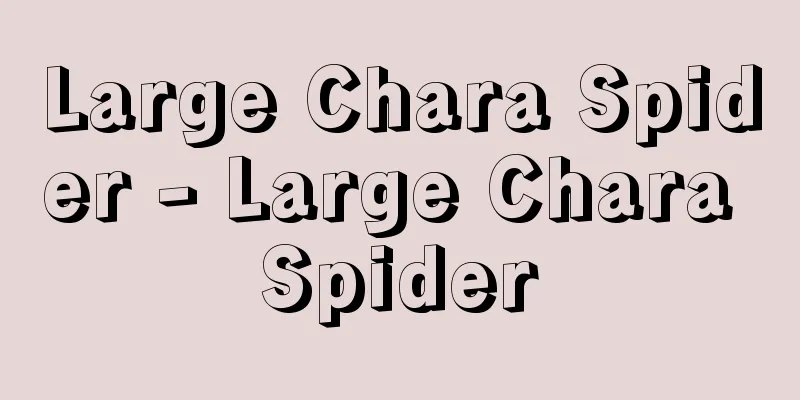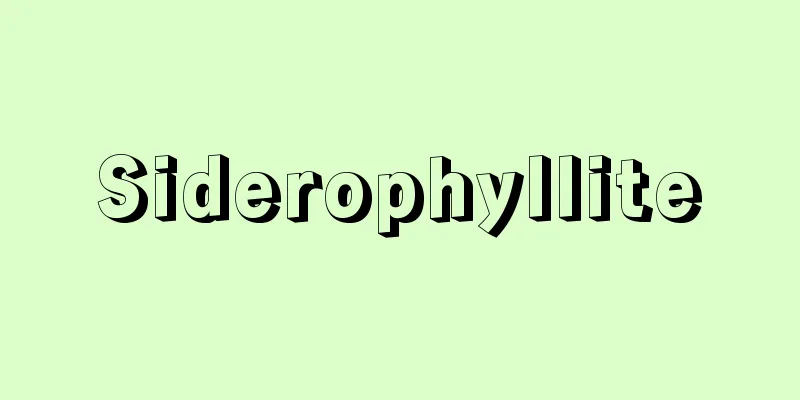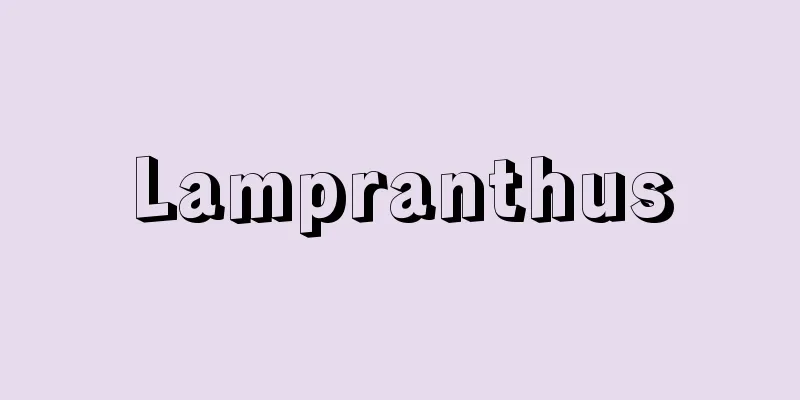Dutch Art

|
In the area that is now the Netherlands, various types of painting began in the 9th century during the Middle Ages, and by the 15th and 16th centuries it had become a major center of early modern European painting. However, since the area before Dutch independence is generally lumped together under the name of Flemish art, this article will focus only on the developments that occurred after independence in the early 17th century. [Kamon Yasuo] 17th to 19th centuriesThe Netherlands, which achieved de facto independence in 1609, came to dominate the world in terms of commerce and trade by the mid-17th century. At the same time, the Netherlands also began to develop its own unique style in the field of art. In architecture, the Renaissance style that had been imported from Italy and Spain was completely transformed into Classicism, and after 1630 the Dutch Classicist style was established, leading to the construction of many city halls, including the Mauritshuis (now a museum of the same name), the residence of Prince Maurits in The Hague, designed by Jacob van Kampen (Campen) (1595-1657), and City Hall in Amsterdam (now the Royal Palace). However, the most noteworthy is the world of painting, where since the flowering of the Northern Renaissance by the Van Eyck brothers in the 15th century, Holland has produced unique, simple and fresh realistic paintings, a tradition that has been passed down continuously, and which became the basis for the creation of genre and landscape paintings not seen in other Western countries during the national development in the 17th century. European painting, which is originally anthropocentric and emphasizes monumental significance, had little room for the development of pure genre paintings that depict the daily life of citizens as they are, or pure landscape paintings that depict nature itself. However, the emergence of an active middle class and the development of commercial power led to the development of a rich civil society in the Netherlands, which has a tradition of realism, and gave birth to familiar paintings that depicted daily life and actual landscapes. The Dutch produced such masters as Frans Hals, Jan Vermeer, Jan Steen, Adrien Brouwer, Gerard Terborgh, and Peter de Hooch in genre painting, and Jacob van Ruisdael, Meindert Hobbema, Paulus Potter, and Jan van Goyen in landscape painting, but it is Rembrandt who stands tall above them in the history of Dutch painting. As a painter of light and soul, he is one of the greatest masters in the history of European painting. In this way, 17th century Dutch painting had a great influence on subsequent European painting, forming the foundations of 19th century French Naturalism and Impressionism. However, Dutch painting itself began to lose its vitality at the end of the 17th century, becoming reduced to craftsmanship, and by the second half of the 19th century it was a copy of French painting. It was not until the emergence of early Impressionists such as Johan Barthold Jongkind and Joseph Israëls that it regained its vitality, and furthermore, with the appearance of the fire painter Van Gogh (Vincent van Hoch), modern Dutch painting was brought into the global spotlight. [Kamon Yasuo] 20th centuryUntil World War IIIn the early 20th century, Kees van Dongen, who had emigrated to France, and the Expressionist painter Jan Sluijters (1881-1957) introduced contemporary French art to their homeland, which was enthusiastically received by young artists. Around 1910, Sluijters, Leo Gestel (1881-1941), Piet Mondrian and others were absorbing contemporary artistic trends such as Cubism and Pointillism and were creating works that emphasized light, a style known as "luminism." Meanwhile, the group De Ploeg (the Plow), which popularized German Expressionism, was active in Groningen. However, it was not until the appearance of De Stijl, a pioneer and representative of an art movement that sought universality and synthesis, that 20th century Dutch art gained international importance. De Stijl, a magazine that means "style," was first published in Leiden in the spring of 1917 and served as the journal of the group of the same name (it ceased publication in 1932). Its founding members included Theo van Doesburg, Bart van der Leck (1876-1958), Georges Vantongerloo (1886-1965), and Mondrian. De Stijl, which was based on the principle of Mondrian's Neoplasticism, can be said to have determined the future of geometric abstract painting. In the field of design, it also played a role in preparing the Neue Sachlichkeit and The Hague School, which were dominant trends in the Netherlands from around the 1920s to the 1930s. However, Neoplasticism soon came under criticism as being dogmatic, and in 1925 Mondrian withdrew from the movement. Meanwhile, the following year in 1926, critic Doesburg advocated "elementalism." The Schröder House in Utrecht (1924) by Gerrit Thomas Rietveld, a member of De Stijl, is considered a masterpiece of 20th century residential architecture, with a free and rich interplay of space made possible by the mobility of neoplastic details. Other architects who are indispensable in the history of modern architecture are Hendrik Petrus Berlage, a pioneer of modern architecture who adapted the weight and texture of bricks of Romanesque architecture with modern rationalism, and Jacobus Johannes Pieter Oud, a leader of the International Style and functionalism, who was also a follower of Berlage. There are also many other architects worth seeing, such as Willem Marinus Dudok (1884-1974), who inspired many imitators in the Netherlands, the Amsterdam School, which criticized Berlage and created expressionist architecture, and the traditionalist Delft School. [Kenjiro Hosaka] Post-World War IIMagical realism and neo-realism were prevalent between the two world wars, but immediately after the Second World War, groups such as "Vrij Beelden," whose members included Piet Ouborg (1893-1956), revived the trend of highly experimental art movements. In the midst of this trend, "Cobra" was formed in 1948, a group of artists who expressed emotion directly, in stark contrast to De Stijl. The group was formed in Paris, and its name was derived from the initials (Co, Br, A) of the capitals of the countries of the participating artists, including Karel Appel and Corneille (1922-2010), Copenhagen, Brussels, and Amsterdam. Although their activity lasted only three years, they played a pioneering role in abstract and expressionist painting and sculpture after the Second World War. Since the 1960s, there have been a variety of artistic trends, including pop art, conceptual art, and neo-expressionism, and the Netherlands was no exception. Among them, paintings by Armando (1929-2018), who expresses the memory of World War II in landscapes, and Marlene Dumas (1953- ), who depicts and questions the gender of the body, are attracting attention. In photography, Ed van Elsken's documentary work, Jan Dibbets (1941- ), who creates optical illusions with skillful arrangements, Rineke Dijkstra (1959- ), who reveals the sociality of the body and family, and Carel Visser (1928-2015) and Henk Visch (1950- ), who are highly regarded for their three-dimensional expressions, are also highly regarded. Furthermore, the various proposals, statements, and practices of architect and urban planner Rem Koolhaas, head of the Office for Metropolitan Architecture (OMA), have encouraged a redefinition of architecture and spawned many followers both in Japan and abroad. [Kenjiro Hosaka] Support from public institutionsSuch creative artistic activities are supported by exhibition facilities that are not large in scale in each city of this country with a population of about 15 million. For example, the Centraal Museum (Utrecht) actively collects contemporary design works by Dick Bruna (1927-2017), the designer of the rabbit character Miffy, and Droog Design, a design organization that attracted attention in the late 1990s by advocating no design. Organizations such as De Appel (Amsterdam), which was founded in 1975, do not have collections, but hold exhibitions as part of their support for the artistic activities of contemporary artists. In Rotterdam, where the Netherlands Architecture Institute (NAi) is located, and The Hague, where the visual arts center Stroom is located, many exhibitions that showcase cutting-edge trends such as contemporary architecture, contemporary music, and media art are held. It would not be wrong to say that this attitude of public institutions recognizing and supporting freedom and creativity is very Dutch. [Kenjiro Hosaka] "Primary Colors of World Art 7: Belgium and the Netherlands" (1983, Shogakukan)" ▽ "A Journey Through World Art 7: The Story of Belgium and the Netherlands" (1988, Sekai Bunka Publishing) ▽ "European Architecture and Interior Guide -- From Historical Buildings to Museums and Shops, Vol. 1" by Tajima Kyoko, Ueda Masako, and Hoshi Kazuhiko (1991, Newhouse Publishing)" ▽ "Masters of the Past: Paintings of Belgium and the Netherlands" by Eugène Fromentin, translated by Suzuki Yoshifumi (1993, Hosei University Press) ▽ "Dutch Architecture" by J.J.P. Oud, translated by Sadatsune Hiroyuki (1994, Chuokoron-Bijutsu Publishing)" ▽ "Bijutsu Gaho 21: Special Feature: 400 Years of Dutch Art" (1999, Asahi Art Communication) [References] | | | | | | | | | | | | | | | | | | | | |Jongkind| |It was built in the 17th century as a Palladian-style city hall. It is currently used as a royal palace. Amsterdam, Netherlands ©Shogakukan "> Royal Palace in Amsterdam 1628-1630 Oil painting, Rijksmuseum, Amsterdam Hals's "The Merry Drinker" Circa 1660 Oil painting , Rijksmuseum, Amsterdam Vermeer's "The Milkmaid" 1665-1668 Oil painting, Rijksmuseum, Amsterdam "> Steen's "The Feast of Saint Nicholas" Circa 1654 Oil painting , Rijksmuseum, Amsterdam Terborgh's "A Father's Admonition" 1656-1660 Oil painting , Rijksmuseum, Amsterdam At the Cellar Door by Hoch 1653 Oil painting , Rijksmuseum, Amsterdam "> Potter's "Cows in a Farm Pasture" 1646 Oil on canvas Paris Museums "> Hoi Yen "Riverside Inn" 1642 Oil painting , Rijksmuseum, Amsterdam "> Rembrandt "The Night Watch" 1865 Oil painting , Metropolitan Museum of Art Jongkind "Honfleur" 1872 Oil painting , Rijksmuseum, Amsterdam "> Israels "Children of the Sea" 1889 Oil painting , Metropolitan Museum of Art Van Gogh's "Wheat Field and Cypresses" Source: Shogakukan Encyclopedia Nipponica About Encyclopedia Nipponica Information | Legend |
|
現在のオランダの地域は、中世は9世紀以来種々の絵画が始まり、15~16世紀になるとヨーロッパ近世絵画の一大中心地を形づくるに至っていた。しかし、一般にオランダ独立以前はフランドル美術の名で総括しているので、ここでは17世紀初頭の独立以降の動きに限って述べる。 [嘉門安雄] 17~19世紀1609年、事実上の独立を達成したオランダは、17世紀中期には商業・貿易の面で世界に君臨するに至った。そして、これと同時に美術の面でも独自の展開が始まった。建築では、前代のイタリア、スペインから移入されたルネサンス様式を一変させて古典主義になり、1630年以降にはオランダの古典主義様式が確立されて、ヤーコプ・ファン・カンペンJacob van Kampen(Campen)(1595―1657)設計のハーグのマウリッツ公邸宅マウリッツハイスMauritshuis(現在は同名の美術館)やアムステルダム市庁舎(現在の王宮)をはじめ多くの市庁舎が次々につくられている。 しかし、もっとも注目すべきは絵画の世界で、15世紀のファン・アイク兄弟による北方ルネサンスの開花以来、独自の素朴清新な写実絵画を生み出し、その伝統は絶えず受け継がれて、それが17世紀の国家的発展に際して、他の西欧諸国にはみられない風俗画、風景画を生み出す基になった。元来、人間中心主義であり、またモニュメンタルな意義を強調してきたヨーロッパ絵画では、市民の日常生活をありのままに描いた純粋な風俗画、あるいは自然そのものを描く純粋な風景画の発展する余地はほとんどなかった。しかし、活動的な市民階級の発生と商業力の発展による市民社会の充実は、写実主義の伝統をもつオランダに、日常生活や実際の風景を写した親しみやすい絵画を生み出した。風俗画にフランス・ハルス、ヤン・フェルメール、ヤン・ステーン、アドリエン・ブロウエル、ヘラルト・テルボルフ、ペーテル・ド・ホーホ、風景画にヤーコプ・ファン・ロイスダール、マインデルト・ホッベマ、パウルス・ポッター、ヤン・ファン・ホーイイエンらの名手が輩出したが、これらを超えてオランダ絵画史にそびえるのはレンブラントである。彼は光の画家、魂の画家として、ヨーロッパ絵画史上最大の巨匠の一人である。 こうして、17世紀のオランダ絵画は以後のヨーロッパ絵画に大きな影響を与え、19世紀フランスの自然主義、印象主義(印象派)の土台を形づくった。しかし、当のオランダの絵画自体は17世紀末から職人的技巧に堕して生気を失い、19世紀後半まで、逆にフランス絵画の亜流を呈していた。それがふたたび生気を取り戻すのは、初期印象派のヨーハン・バルトルト・ヨンキントやヨセフ・イスラエルスの出現によってであり、さらに炎の画家ゴッホ(フィンセント・ファン・ホッホ)の登場によって、近代オランダ絵画は世界的に大きな脚光を浴びた。 [嘉門安雄] 20世紀第二次世界大戦まで20世紀初頭、フランスに移住したキース・バン・ドンゲンや、表現主義的画家のヤン・スリューテルJan Sluijters(1881―1957)が祖国に紹介した同時代フランス美術は、若い作家に熱狂的に迎えられた。1910年前後には、スリューテルやレオ・ゲシュテルLeo Gestel(1881―1941)、ピエト・モンドリアンらがキュビスムや点描主義など同時代の芸術動向を吸収しながら「ルミニズムluminism」とよばれる光を重視した作品を制作していた。一方、ドイツ表現主義を広めたグループ「デ・プローグDe Ploeg」(鋤(すき))のフローニンゲンを本拠地とした活動もあった。しかしオランダの20世紀芸術が国際的な重要性を獲得するのは、普遍性と総合性を求める芸術運動の先駆的、代表的な存在であるデ・ステイルの登場を待たなければならない。1917年の春ライデンで発刊された「様式」を意味する雑誌『デ・ステイル』は、同名をもってよばれるグループの機関誌的役割を担っていた(1932終刊)。発足時のメンバーには、テオ・ファン・ドースブルフ、バルト・ファン・デル・レックBart van der Leck(1876―1958)、ジョルジュ・ファントンゲルローGeorges Vantongerloo(1886―1965)、そしてモンドリアンなどがいた。基本的にモンドリアンが唱える「新造形主義」を原理としていたデ・ステイルは、幾何学的抽象絵画のその後のあり方を決定づけたといえる。またデザインの領域においても、1920年ごろから1930年代までのオランダにおいて支配的傾向であった新即物主義やハーグ派を準備する役割を担った。しかし、やがて新造形主義を教条的だとする批判も生じ、1925年、モンドリアンはこの運動から身を引き、一方翌1926年、批判者ドースブルフは「エレメンタリズム」を提唱することになる。 デ・ステイルのメンバーでもあったヘリット・トーマス・リートフェルトによるユトレヒトのシュレーダー邸(1924)は、空間の自由で豊かな相互関与が新造形主義的なディテールの可動性によって可能となっており、20世紀住宅建築の代表作と目されている。建築ではほかに、ロマネスク建築の重量感とれんがの素材感を近代的合理主義によって翻案した、近代建築の先駆者ヘンドリック・ペトルス・ベルラーヘや、国際様式、機能主義の泰斗であると同時にベルラーヘの信奉者でもあったヤコブス・ヨハネス・ピーテル・アウトの存在が近代建築史を語るうえで欠かせない。またオランダ国内に多くの模倣者を生み出したビレム・マリナス・デュドックWillem Marinus Dudok(1884―1974)や、ベルラーヘを批判し表現主義的建築をつくったアムステルダム派、伝統主義的なデルフト派など見るべきものは多い。 [保坂健二朗] 第二次世界大戦以降二度にわたる世界大戦の間は魔術的リアリズムやネオ・リアリズムが大勢であったが、第二次世界大戦後すぐにピエト・アウボルフPiet Ouborg(1893―1956)をメンバーの一人とするグループ「自由なイメージVrij Beelden」などが、実験性の強い芸術運動の流れを再興した。こうした動向のなかで1948年結成されたのが、デ・ステイルとは対極的な、感情を無媒介的に表出する芸術家のグループ「コブラ」である。結成自体はパリであるこのグループの名は、カレル・アペルやコルネイユCorneille(1922―2010)など、参加した各作家の生国の首都であるコペンハーゲン、ブリュッセル、アムステルダムの頭文字(Co、Br、A)から名づけられている。活動は約3年間と短命であったものの、第二次世界大戦後の抽象的かつ表現主義的な絵画や彫刻の先駆的役割を担った。 1960年代以降、ポップ・アート、コンセプチュアル・アート、ネオ・エクスプレッショニズム(新表現主義)など多様化をきわめる芸術の動向がみられたが、オランダもまたその例外ではなかった。そのなかで、第二次世界大戦の記憶を風景表現に表出するアルマンドArmando(1929―2018)や、身体のジェンダー性を描き問うマルレーネ・デュマスMarlene Dumas(1953― )の絵画が注目される。また写真では、ドキュメンタリー的なエド・ファン・エルスケン、巧みな配置で錯視をおこさせるヤン・ディベッツJan Dibbets(1941― )、身体・家族の社会性を顕示させるリネケ・ダイクストラRineke Dijkstra(1959― )など、立体表現ではカレル・フィッサーCarel Visser(1928―2015)やヘンク・フィッシュHenk Visch(1950― )などの評価が高い。またOMA(Office for Metropolitan Architecture)を主宰する建築家・都市計画家のレム・コールハースによるさまざまな提案、発言、実践は、建築の再定義を促し、国内外に多くの追随者を生み出した。 [保坂健二朗] 公的機関によるサポートこうした創意的な芸術活動を支えているのが、人口約1500万人のこの国の各都市に存在する、けっして大規模ではない展示施設である。たとえばセントラル美術館(ユトレヒト)は、ウサギのキャラクター、ミッフィーのデザイナーであるディック・ブルーナDick Bruna(1927―2017)や、1990年代後半、ノーデザインを提唱し注目を集めたデザイナー組織「ドローク・デザインDroog Design」といった同時代のデザイン作品を積極的に収蔵している。また、1975年に設立された「デ・アペルDe Appel」(アムステルダム)のような組織などは、コレクションをもたず、展覧会を同時代作家の芸術活動のサポートの一環として行っている。オランダ建築研究所(NAi)があるロッテルダムや、視覚芸術センター「シュトゥルームStroom」があるハーグでは、現代建築や現代音楽、あるいはメディア・アートなど、最先端の動向を打ち出す展覧会が数多く行われている。公的機関が自由と創意を認め、それをサポートするこのような姿勢を、いかにもオランダ的だといったとしても間違いではないだろう。 [保坂健二朗] 『『原色世界の美術7 ベルギー・オランダ』(1983・小学館)』▽『『世界美術の旅7 ベルギー・オランダ物語』(1988・世界文化社)』▽『田島恭子・上田雅子・星和彦著『ヨーロッパの建築・インテリアガイド――歴史的建築物から美術館、ショップまで 上』(1991・ニューハウス出版)』▽『ウジェーヌ・フロマンタン著、鈴木祥史訳『昔日の巨匠たち ベルギーとオランダの絵画』(1993・法政大学出版局)』▽『J・J・P・アウト著、貞包博幸訳『オランダ建築』(1994・中央公論美術出版)』▽『『美術画報21 特集オランダ美術の400年』(1999・朝日アートコミュニケーション)』 [参照項目] | | | | | | | | | | | | | | | | | | | | | | | | | | | | | |17世紀にパラディオ様式の市庁舎として建てられた。現在は王宮として使用されている。オランダ アムステルダム©Shogakukan"> アムステルダムの王宮 1628~1630年ころ 油彩アムステルダム国立美術館所蔵"> ハルス『陽気な酒飲み』 1660年ころ 油彩アムステルダム国立美術館所蔵"> フェルメール『牛乳を注ぐ女』 1665~1668年 油彩アムステルダム国立美術館所蔵"> ステーン『聖ニコラウスの祭り』 1654年ころ 油彩アムステルダム国立美術館所蔵"> テルボルフ『父親の訓戒』 1656~1660年ころ 油彩アムステルダム国立美術館所蔵"> ホーホ『地下室の戸口にて』 1653年 油彩アムステルダム国立美術館所蔵"> ポッター『農場の牧草地の牛』 1646年 油彩ParisMusées"> ホーイイエン『河畔の宿』 1642年 油彩アムステルダム国立美術館所蔵"> レンブラント『夜警』 1865年 油彩メトロポリタン美術館所蔵"> ヨンキント『オンフルール』 1872年 油彩アムステルダム国立美術館所蔵"> イスラエルス『海の子どもたち』 1889年 油彩メトロポリタン美術館所蔵"> ゴッホ『麦畑と糸杉』 出典 小学館 日本大百科全書(ニッポニカ)日本大百科全書(ニッポニカ)について 情報 | 凡例 |
<<: Dutch rumours - Dutch rumours
>>: Dutch aircraft - Dutch flier
Recommend
preestablished harmony
One of the fundamental metaphysical principles of ...
Production control
It is a series of management activities carried o...
Chemical plating - Kagaku plating
In contrast to electroplating, which is the mainst...
Can you cut it? Can you cut it?
...Ayu intestines and their salted fish. Those ma...
Konoe Iehiro
A nobleman in the mid-Edo period. Calligrapher. Re...
Iran - Iran (English spelling)
Overview An Islamic republic in the Middle East. ...
Langlois, H. (English spelling) LangloisH
…It should not be forgotten that there was a pion...
Summary of Legal Studies - Institutiones Iustiniani
Emperor Justinian expanded the Byzantine Empire an...
Bodélé Depression
An undeveloped lowland located in central-northern...
Kamanja - Kamanja
...It has three strings and a thin wooden surface...
Straw shoes (warakutsu) - straw shoes
Woven straw shoes for use in the snow. Also called...
Hubli‐Dārwār (English spelling)
An industrial city in the mid-west of Karnataka st...
Dancing Nembutsu - Odorinembutsu
A dance in which many people dance while chanting ...
Cape (English spelling)
A former province that occupied the southwestern h...
Rusutsu [village] - Rusutsu
A village in Abuta County, Shiribeshi Subprefectur...









